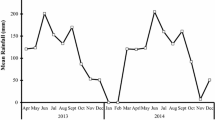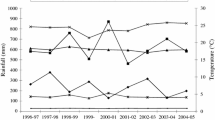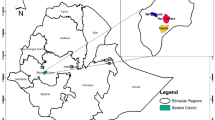Abstract
Decline in crop yields is a major problem facing smallholder farmers in Kenya and the entire Sub-Saharan region. This is attributed mainly to the mining of major nutrients due to continuous cropping without addition of adequate external nutrients. In most cases inorganic fertilizers are expensive, hence unaffordable to most smallholder farmers. Although organic nutrient sources are available, information about their potential use is scanty. A field experiment was set up in the sub-humid highlands of Kenya to establish the chemical fertilizer equivalency values of different organic materials based on their quality. The experiment consisted of maize plots to which freshly collected leaves of Tithonia diversifolia (tithonia), Senna spectabilis (senna) and Calliandra calothyrsus (calliandra) (all with %N>3) obtained from hedgerows grown ex situ (biomass transfer) and urea (inorganic nitrogen source) were applied. Results obtained for the cumulative above ground biomass yield for three seasons indicated that a combination of both organic and inorganic nutrient source gave higher maize biomass yield than when each was applied separately. Above ground biomass yield production in maize (t ha−1) from organic and inorganic fertilization was in the order of senna+urea (31.2), tithonia+urea (29.4), calliandra+urea (29.3), tithonia (28.6), senna (27.9), urea (27.4), calliandra (25.9), and control (22.5) for three cumulative seasons. On average, the three organic materials (calliandra, senna and tithonia) gave fertilizer equivalency values for the nitrogen contained in them of 50, 87 and 118%, respectively. It is therefore recommended that tithonia biomass be used in place of mineral fertilizer as a source of nitrogen. The high equivalency values can be attributed to the synergetic effects of nutrient supply, and improved moisture and soil physical conditions of the mulch. However, for sustainable agricultural production, combination with mineral fertilizer would be the best option.
Similar content being viewed by others
References
Becker M., Ladha J.K. and Ottow J.C.G. 1994. Nitrogen losses and lowland rice yield as affected by residue nitrogen release. Soil Sci. Soc. Am. J. 58: 1660-1665.
Chen Y. and Avnimelech Y. (eds) 1986. The Role of Organic Matter in Modern Agriculture. Martinus Nijhoff Publishers, Dordrecht, The Netherlands.
Delve R., Gachengo C., Adams E., Palm C., Cadisch G. and Giller K.E. 2000. The organic resource database. In: The Biology and Fertility of Tropical Soils: A TSBF Report 1997-1998. pp. 20–22.
FAO Food and Agriculture Organization 1990. New Environmental Threat: Declining Soil Fertility. Land and Water Technical Newsletter.
Gachengo C.N. 1996. Phosphorus release and availability on addition of organic materials to phosphorus fixing soils. M.Phil. Thesis. Moi University, Eldoret, Kenya.
Gachengo C.N., Palm C.A., Jama B. and Otieno C. 1999. Tithonia and senna green manures and inorganic fertilizers as phosphorus sources for maize in Western Kenya. Agrofor. Syst. 44: 21–36.
Jama B., Palm C.A., Buresh R.J., Niang A., Gachengo C., Nziguheba G. and Amadalo B. 2000. Tithonia diversifoliaas a green manure for soil fertility improvement in western Kenya: a review. Agrofor. Syst. 49: 201–221.
Kang B.T., Reynolds L. and Atta-Krah A.N. 1990. Alley farming. Adv. Agron. 43: 315–359.
Lehmann J., Schroth G. and Zech W. 1995. Decomposition and nutrient release from leaves, twigs and roots of three alleycropped tree legumes in Central Togo. Agrofor. Syst. 29: 21–36.
Lehmann J., Feilner T., Gebauer G. and Zech W. 1999. Nitrogen uptake of sorghum Sorghum bicolorL. from tree mulch and mineral fertilizer under high leaching conditions estimated by nitrogen-15 enrichment. Biol. Fertil. Soils 30: 90–95.
Mugendi D.N. 1997. Tree biomass decomposition, nitrogen dynamics and maize growth under agroforestry conditions in the sub-humid highlands of Kenya. Ph.D. Thesis, University of Florida, Gainesville, FL.
Mugendi D.N., Nair P.K.R., Mugwe J.N., O'Neill M.K., Swift M.J. and Woomer P. 1999. Alley cropping of maize with Calliandra and Leucaena in the Sub-humid highlands of Kenya. Part 2: Biomass decomposition, N mineralization, and N uptake by Maize. Agrofor. Syst. 46: 51–64.
Murwira H.K., Mutuo P.K., Nhamo N., Marandu A.E., Rabeson R., Mwale M. and Palm C.A. 2002. Fertilizer equivalency values of organic materials of differing quality. In: Vanlauwe B., Diels J., Sanginga N. and Merckx R. eds, Integrated Plant Nutrient Management in Sub-Saharan Africa. CABI Publishing, Wallingford, UK.
Mwale M., Mapiki A. and Phiri L.K. 2000a. Optimal combinations of organic and inorganic N sources. In: The Biology and Fertility of Tropical Soils: A TSBF Report 1997-1998. pp. 38–40.
Mwale M., Mapiki A. and Phiri L.K. 2000b. To synchronize nutrient availability with plant uptake. In: The Biology and Fertility of Tropical Soils: A TSBF Report 1997-1998. pp. 40–41.
Mwaura F.M. and Woomer P.L. 1999. Fertilizer retailing in the Kenyan Highlands. Nutrient Cycl. Agroecosyst. 55: 107–116.
Myers R.J.K., Palm C.A., Cuevas E., Gunatilleke I.U.N. and Brossard M. 1994. The synchronization of nutrient mineralization and plant nutrient demand. In:Woomer P.L. and Swift M.J. eds, The Biological Management of Soil Fertility. Wiley, Chichester, UK.
Palm C.A. 1995. Contribution of agroforestry trees to nutrient requirements of intercropped plants. Agrofor. Syst. 30: 105–124.
Palm C.A., Myers R.J.K. and Nandwa S.M. 1997. Combined use of organic and inorganic nutrient sources for soil fertility maintenance and replenishment. In: Buresh R.J. and Sanchez P.A. eds, Replenishing Soil Fertility in Africa. SSSA Special Publication 51. SSSA, Madison, WI.
Palm C.A., Gachengo C.N., Dalve R.J., Cadisch G. and Giller K.E. 2001. Organic inputs for soil fertility management in tropical agroecosystems: application of an organic resource database. Agric. Ecosyst. Environ. 83: 27–42.
Swift M.J. 1987. Tropical Soil Biology and Fertility: Interregional Research Planning Workshop, Special Issue 13, in Biology International IUBS, Paris.
Vanlauwe B., Aihou K., Houngnandan P., Diels J., Sanginga N. and Merckx R. 2001. Nitrogen management in 'adequate' input maize-based agriculture in the derived savanna benchmark zone of Benin Republic. Plant Soil 228: 61–71.
Wallace J.S. 1996. The water balance of mixed tree-crop systems. In: Ong C.K. and Huxley P. eds, Tree-crop Interactions, A Physiological Approach. CAB International, Wallingford, UK, pp. 73–158.
Rights and permissions
About this article
Cite this article
Kimetu, J., Mugendi, D., Palm, C. et al. Nitrogen fertilizer equivalencies of organics of differing quality and optimum combination with inorganic nitrogen source in Central Kenya. Nutrient Cycling in Agroecosystems 68, 127–135 (2004). https://doi.org/10.1023/B:FRES.0000019043.33580.a6
Issue Date:
DOI: https://doi.org/10.1023/B:FRES.0000019043.33580.a6




